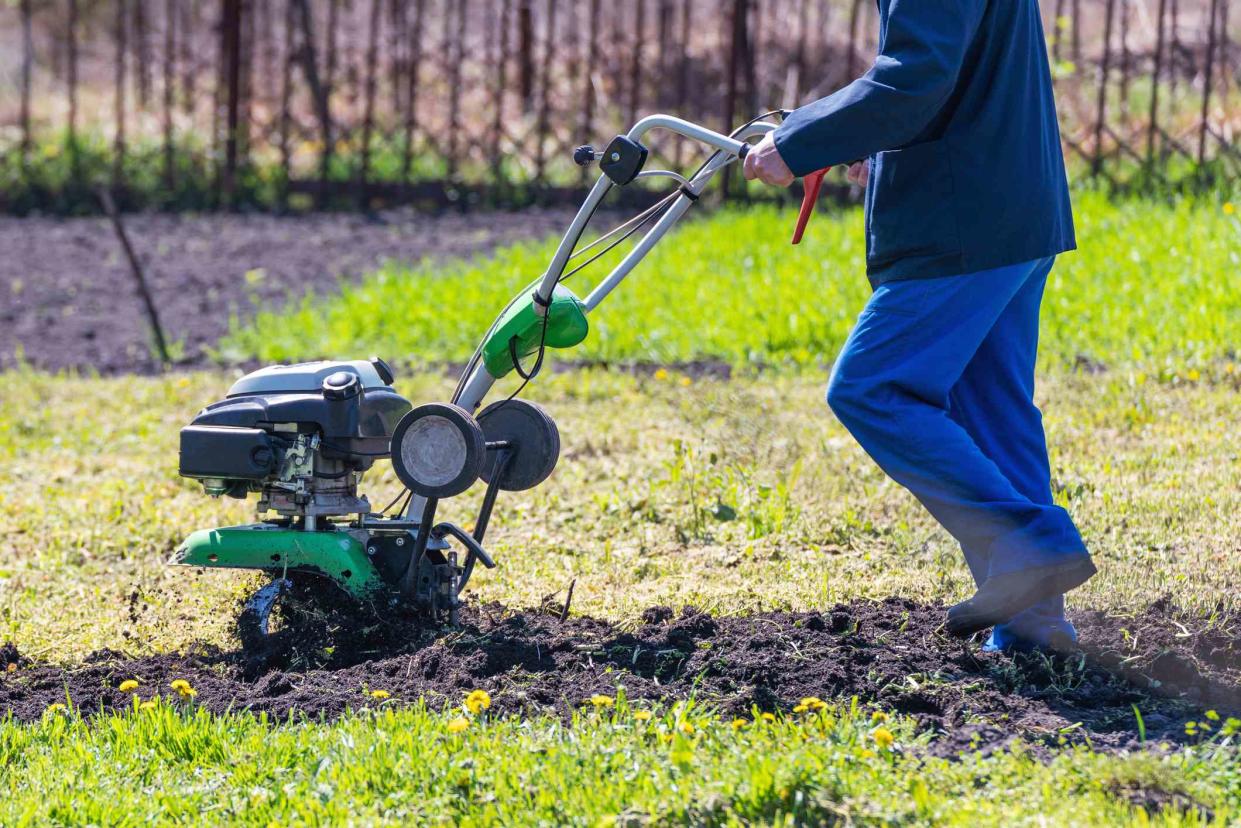Cultivator vs. Tiller: Which Do You Need?

Andrei310 / Getty Images
Gardening is enjoyable, but it can also be a lot of work. Having the right tool for the job can make gardening work much more efficient, and help prevent over-exertion. Tillers and cultivators are useful tools for prepping the garden for planting. These tools, while similar, have different features and functions which make them suitable for specific purposes.
What Is a Tiller?
A tiller is a motorized garden tool with blades designed to loosen soil to help make planting easier. Most agriculture utilizes tilling of soil. In recent years, "no-till" farming has become an option to help preserve dry or sandy soils from erosion. But for clay soils or those containing suitable moisture, tilling helps break up clods so that amendments may be added (to improve texture), and so that crops may be planted.
Front End Tillers
A front end tiller, also referred to as a "front tine tiller" is designed with the blades in front of the motor structure. Because these tillers can be a bit harder to maneuver when used in heavier soils, they are intended for lighter duty jobs than rear end tillers.
Rear End Tillers
A read end or rear tine tiller has the tilling blades placed behind the tool's motor. This provides more stability than a front end design, and is more suitable for heavier soils and use on compacted grass.
What Is a Cultivator?
A cultivator is also a motorized tool that, like a tiller, is designed to loosen the top few inches of soil prior to planting. It usually has lighter blades than a tiller, and is often used to mix in soil amendments. Tillers are useful to get your vegetable garden ready for planting in spring.
Feature | Tiller | Cultivator |
Size | Large | Average to small |
Weight | Heavy (100-200 lbs) | Light (30-40 lbs) |
Tilling Depth | 8-10 inches | 1-6 inches |
Tilling Width | Wide, 18-36 inches | Narrow, up to 16 inches |
Ease of Use | Tricky to maneuver | Easier for compact spaces |
Best Used For | Breaking up heavy compacted soils | Loosening garden soil for adding amendments |
Cost | $200-2000 | $50-400 |
Cultivator vs. Tiller: Which Should You Choose?
The main functional differences between the two tools are related to their size, weight, and power.
Cultivators are smaller and lighter in weight than tillers, and are intended for preparing already established vegetable or flower beds for planting, by loosening the top layer of soil. Cultivators are also useful for mixing in soil amendments. They're easier and faster to use for this purpose than traditional hand tools like a hoe or hand spade.
Cultivators are for smaller projects that require a bit more ease of movement and finesse. Because they are lighter and easier to maneuver than tillers, they can be used for garden preparation, and can reach into corners if used carefully. Cultivators can also be stored more efficiently due to their size, and some models even break down into motor and handle sections for easy storage.
Tillers are for heavy duty work such as making a new planting area like a vegetable garden or flower bed. Tillers are a more heavy duty piece of equipment than cultivators, and are not only heavier, they have larger motors, and tend to cost a lot more to purchase. As a rule, if you're trying to dig in hard, compacted soil, or very thick clay soil, or in a thick lawn, you need a tiller. Tillers can also be digging tools for trenches or to prep for small projects such as water features.
Some gardeners might be tempted to get a cultivator because it's easier to use and less expensive, but it's not designed for the same purposes as a tiller. For example, a cultivator isn't powerful enough to really dig through established meadow grass or for rocky soil, and its thinner blades might get tangled in thick grass roots or damaged by rocks.
Since tillers usually cost more than cultivators, you may want to consider the option of renting a tiller from a local dealer or garden shop, especially for a one-time project. Similarly, if you only need to use a cultivator once during the season (for example, getting your veggie garden ready for planting in spring), these can also be rented.
Once you decide whether to get a tiller or cultivator, explore the different features available to determine what is best for you. Tillers can range from light duty to very heavy duty, and most are gas powered. There are gas, electric, and battery powered cultivators available.
Some models may have blades that can be adjusted for width or depth. Since these tools represent a considerable investment, choose brands with good consumer ratings, and with a good warranty if possible.
Frequently Asked Questions
Can I use a cultivator for tilling a garden?
If your garden is small and well-established, and has well-draining, loamy soil free of large rocks, you should be able to use a cultivator to till the top layer (up to 6 inches deep).
What does a cultivator work best for?
Ideally, a cultivator is used for loosening the top layer of garden soil. It's also a good tool for mixing in soil amendments, and does this more efficiently and easily than a hoe or rake.
Does a cultivator work even with grass?
A cultivator's blades are generally too lightweight to be effective at breaking up sod or clumps of grass. You might even damage the blades if the grass gets tangled in them. For digging up a lawn or grassy area, a tiller is a better choice.
Read Next: Fill Dirt vs. Topsoil: Differences and Which to Use
Read the original article on The Spruce.

